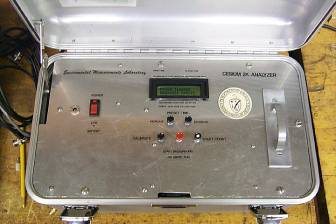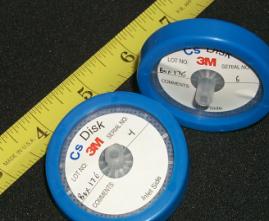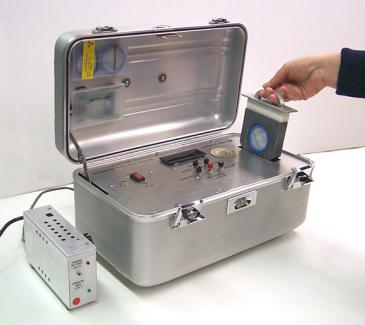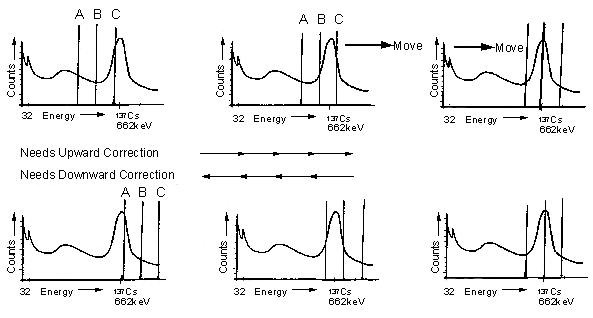CESIUM 2k ANALYZER – A
PORTABLE INSTRUMENT FOR 137Cs IDENTIFICATION AND COUNTING
Norman Latner, Norman Chiu,
and Anna Berne
Environmental
Measurements Laboratory
U. S. Department of Energy
New York, NY 10014-4811
Introduction
 The Cesium 2k Analyzer (Figure 1) was designed by the
Environmental Measurements Laboratory (EML) to evaluate the activity of 137Cs
collected on Empore Rad disks. The
cesium specific Empore disks are an experimental product, and prior to the
development of this unit, no portable instrument was available for evaluating
the activity collected on the disks.
Empore Rad disks, developed jointly by 3M Industrial Products and
Argonne National Laboratory, are densely packed sampling disks fabricated with
element selective particles to separate, collect and concentrate target
radioisotopes on the surface of the disk.
Because they exhibit a low liquid flow resistance, and are relatively
immune to different elements that simply pass through the disk, a high recovery
of the target isotope can be achieved.
These Rad disks are ideal for quantitative determination of a specific
isotope in aqueous solutions, offering an effective alternative to standard
radiochemical sample preparation methods.
The Cesium 2k Analyzer (Figure 1) was designed by the
Environmental Measurements Laboratory (EML) to evaluate the activity of 137Cs
collected on Empore Rad disks. The
cesium specific Empore disks are an experimental product, and prior to the
development of this unit, no portable instrument was available for evaluating
the activity collected on the disks.
Empore Rad disks, developed jointly by 3M Industrial Products and
Argonne National Laboratory, are densely packed sampling disks fabricated with
element selective particles to separate, collect and concentrate target
radioisotopes on the surface of the disk.
Because they exhibit a low liquid flow resistance, and are relatively
immune to different elements that simply pass through the disk, a high recovery
of the target isotope can be achieved.
These Rad disks are ideal for quantitative determination of a specific
isotope in aqueous solutions, offering an effective alternative to standard
radiochemical sample preparation methods.
Figure 1.
The Cesium 2k Analyzer.
Design
The EML Cesium 2k Analyzer identifies and counts the 662 keV
gamma-rays that are emitted from the Empore Cesium Rad disks (Figure 2),
subtracts out the previously collected background in proper proportion, and
shows the net activity on its digital display.
It is configured as a 32-pound portable field instrument that will
operate for 56 h after recharging. The
unit uses an on-board cesium-tracking source to establish a calibration before
use at a location, thus allowing the instrument to operate over a wide range of
environmental temperatures and conditions.
While the design is based on a microcomputer, making it easy to operate,
every effort was made to keep the cost below $2,000, rather than the $10-12,000
it typically costs using a more conventional multichannel analyzer and notebook
computer approach.
This unit was designed for simplicity of operation and has
only five operating keys. These
operating keys allow the user to choose a counting time, select the calibration
procedure, or start a background or sample run. The keys also permit a run to be aborted at any time. The two-line LCD display shows information
that relates to, and identifies, the mode that the unit is in. While counting, a flashing display is shown,
as well as preset and elapsed counting times.
Background count is shown both as total count for the preset period, and
in counts per minute (cpm). The net
sample data is shown as a total count, but the program can be modified to
indicate activity in radiation units.
The calibration screen shows a tracking number that gives the user an
indication of how much correction was supplied.
 The design of this instrument often involved a balance,
or compromise, between opposing elements.
The $2,000 price constraint limited the choices to comparatively
inexpensive detector, computer and circuit elements, and, thus, increased the
design complexity. As a portable
instrument, there was a need to minimize the shield to keep the weight down,
but at the same time, more shielding lowers the background and leads to greater
sensitivity. Similarly, a larger size
detector increases sensitivity, but at the cost of a larger and heavier
shield. Using a $49 computer (Basic
Stamp II) was cost effective, but required much time-consuming
programming. At times it was possible
to use the same components in several ways to achieve economies. Rather than using a single 12 V lead acid
battery, two 6 V series wired units were used.
These batteries were arranged so as to straddle the detector, thus
effectively augmenting the shielding, and further reducing the background by
18%.
The design of this instrument often involved a balance,
or compromise, between opposing elements.
The $2,000 price constraint limited the choices to comparatively
inexpensive detector, computer and circuit elements, and, thus, increased the
design complexity. As a portable
instrument, there was a need to minimize the shield to keep the weight down,
but at the same time, more shielding lowers the background and leads to greater
sensitivity. Similarly, a larger size
detector increases sensitivity, but at the cost of a larger and heavier
shield. Using a $49 computer (Basic
Stamp II) was cost effective, but required much time-consuming
programming. At times it was possible
to use the same components in several ways to achieve economies. Rather than using a single 12 V lead acid
battery, two 6 V series wired units were used.
These batteries were arranged so as to straddle the detector, thus
effectively augmenting the shielding, and further reducing the background by
18%.
Figure 2.
Empore Cesium Rad Disks.
Operation
The first step in operating the Cs2k analyzer
is loading the on-board calibration source and starting the automatic
calibration routine (Figure 3). This procedure corrects for any gain shifts and
establishes the proper starting point.
The process may take 1 to 3 min while the computer compares the number
of counts in two adjacent counting windows (Figure 4). The computer successively shifts both
windows towards the higher count region, until the counts in both windows are
equal and the cesium 662 keV peak is centered.
 A sample blank is counted next to yield a background
count. The preset time is set by the
increment/decrement keys and adjusted to a value between 1 and 100 min. A longer background count is always
advantageous when the expected sample count is low, since this reduces the
standard deviation and increases the confidence of the result. Only one background count needs to be taken
per location. This stored count will be
proportionally applied to all subsequent sample counts.
A sample blank is counted next to yield a background
count. The preset time is set by the
increment/decrement keys and adjusted to a value between 1 and 100 min. A longer background count is always
advantageous when the expected sample count is low, since this reduces the
standard deviation and increases the confidence of the result. Only one background count needs to be taken
per location. This stored count will be
proportionally applied to all subsequent sample counts.
Prior
to counting a sample, the protruding luer fittings are clipped off both sides
of the Empore Rad disk using the on-board clipper. A count time is then entered and counting started. Here again, a longer count leads to better
statistics. At the completion of
counting, the display shows preset time, elapsed time, total gross count and
total net count.
Figure 3.
Loading a sample into the unit.

Figure 4. Automatic calibration routine.
Brief description of the
Cs2k analyzer circuitry
The block diagram is shown as Figure
5. At left is the detector, a 2x2-inch
sodium iodide inline unit with the crystal surrounded by a 0.5-inch lead
shield. The shield section that covers the end of the detector also serves as
the sample holder. A commercial preamplifier and base unit was used. Bias for the detector is supplied via a d.c.
to d.c. high voltage converter module whose output is adjusted by a precision
regulator circuit.
The signal from the preamplifier,
having an amplitude proportional to the detected gamma energy, is routed to
three comparitors. Each comparitor is
adjusted to a particular level and only pulses exceeding that level pass
through that comparitor. As shown in
the figure, level A includes the entire cesium peak and above, level B
encompasses the middle of the peak and above, while level C accepts only the
counts above the peak. The critical
voltages that set the comparitors are actually generated by the “Basic Stamp”
computer software and thus can be easily adjusted. This process is accomplished by converting the computer’s digital
output to the analog levels needed for the comparitors, using Digital-to-Analog
converters and a precision reference.
The pulse outputs from the comparitors are accumulated in three counters
and periodically shifted into the computer.
The computer, programmed in
basic, forms the counting windows A-B and B-C, which are combined to count the
entire cesium peak, or used separately during the calibration routine. During this procedure, a short run is made
and the counts in A-B and B-C are compared. If they are not equal, levels A, B
and C are simultaneously shifted in the direction of the higher count window
and a new run is made. The process is
repeated until the windows are balanced, at which point the unit is energy
calibrated. The computer controls all
display functions. A crystal clock circuit supplies the basic clock functions
needed by the computer.

Figure
5. Block diagram.
Results and Discussion
The Cs2k analyzer exhibits a broad
measurement range of from less than 50 pCi to over 400, 000 pCi. At the higher counting rates, short count
times are adequate and the background contribution becomes less important. A series of replicate counter measurements
were made, using different source strength samples, to give statistical
assurance of counter reliability. The
background rate during these tests was about 70 cpm. For a source rated at 141,800 pCi, and a count time of 5 min, the
mean count was 20,135 " 80 cpm. Since the calculated value of 2 sigma (95%)
is " 282 cpm, these data are
quite good. A lower activity source of
15,080 pCi counted for 10 min gave a mean value of 1864 " 18 cpm, compared to " 86, the calculated value of
2 sigma. At levels approaching the
lower limit, a 60 pCi sample, using 60 min count times and a 60 min background,
results in a mean value of 6.2 " 2 cpm. These results are good since the calculated
2 sigma value is " 3 cpm. Finally, 20 min runs with a
120 pCi sample and a 60 min background gave mean
values of 13.3 " 4.0 cpm compared to the
calculated 2 sigma value of " 4.6 cpm.
The
Cs2k analyzer was developed for rugged field use and was built using a
heavy-duty aluminum case. With 56 h of
run time per battery recharge, it offers a good week of operation on its own
power, or will operate continuously with its charger plugged in. When closed, the unit is relatively
watertight. Temperature tests, which
were run on the most thermally sensitive parts of the system, indicate a
conservative operating range of 30 to 100oF.
While
this unit was primarily intended to measure 137Cs, it can, with not
much effort, be modified to measure a variety of other monoenergetic gamma rays.